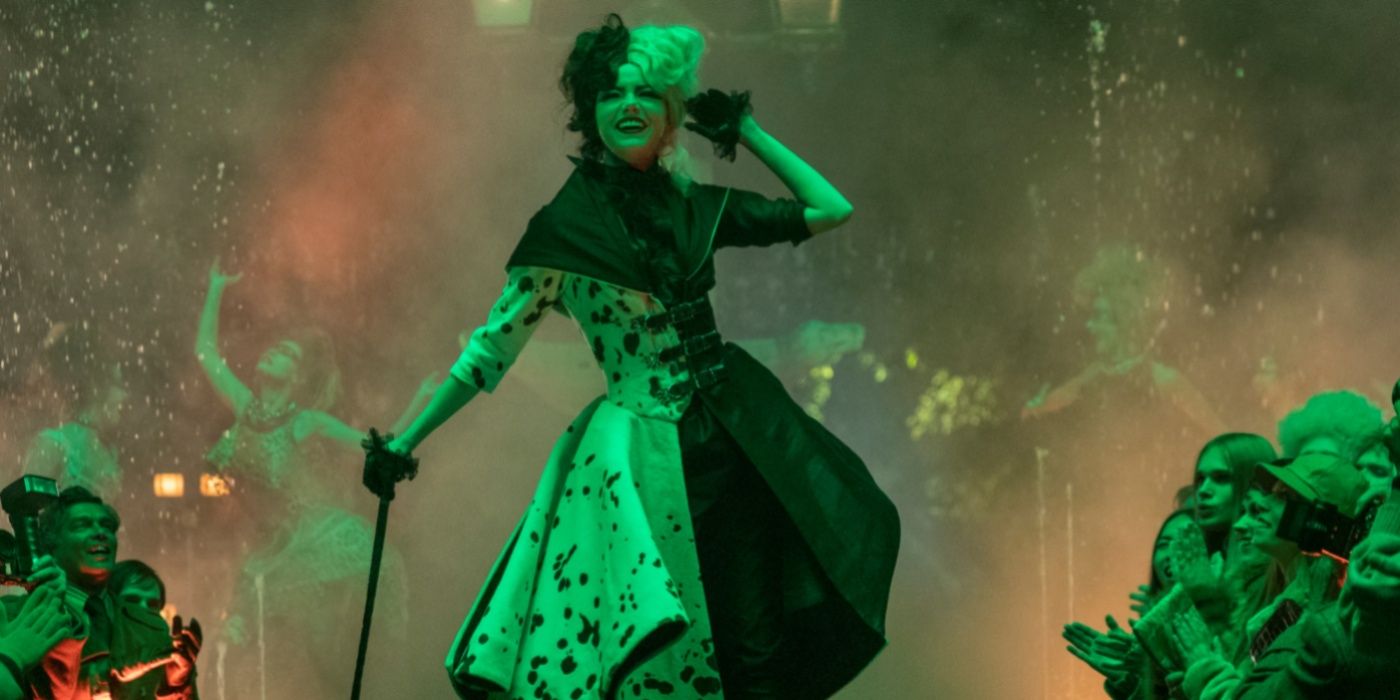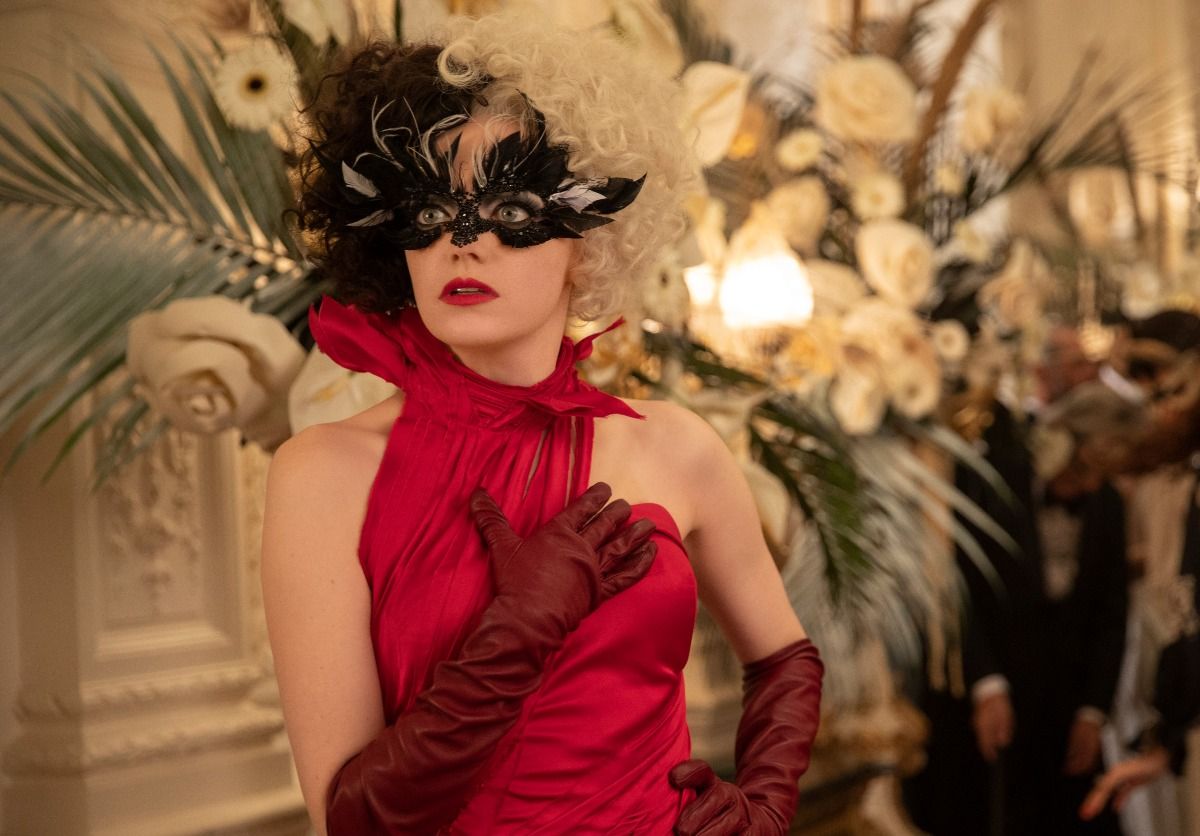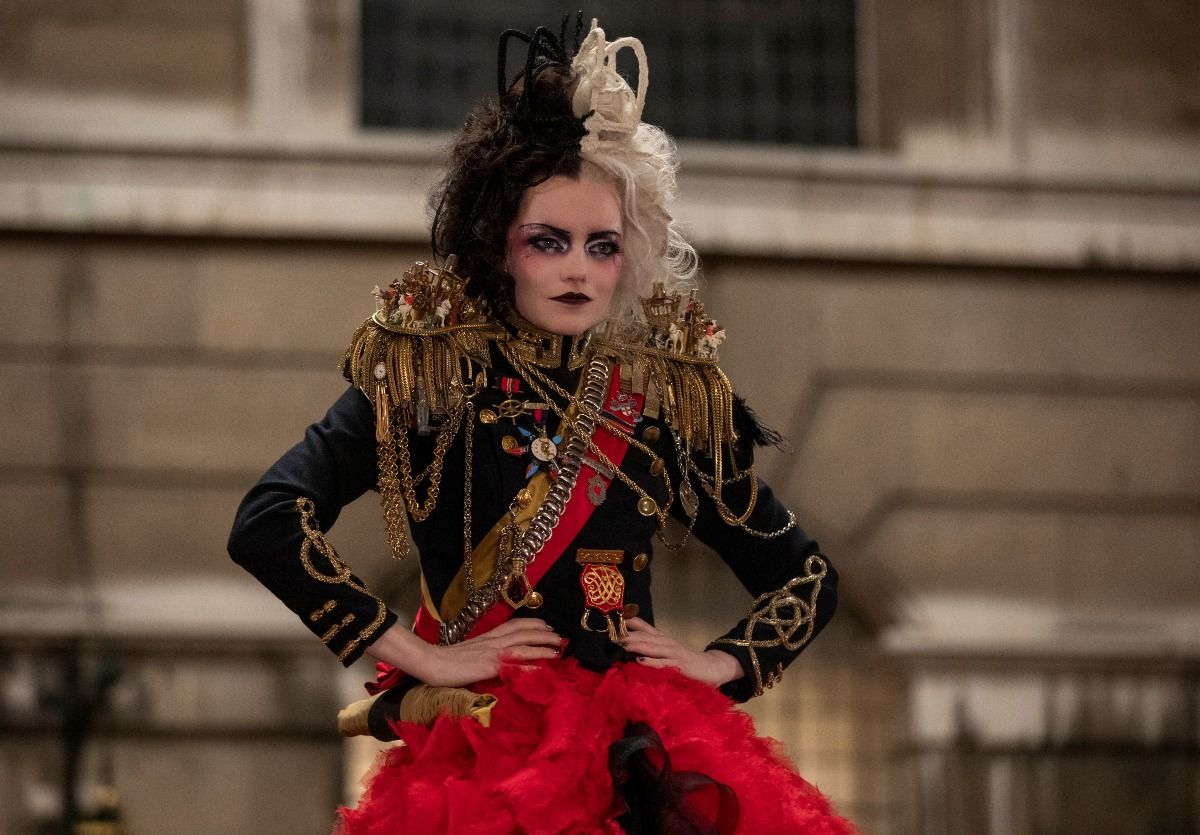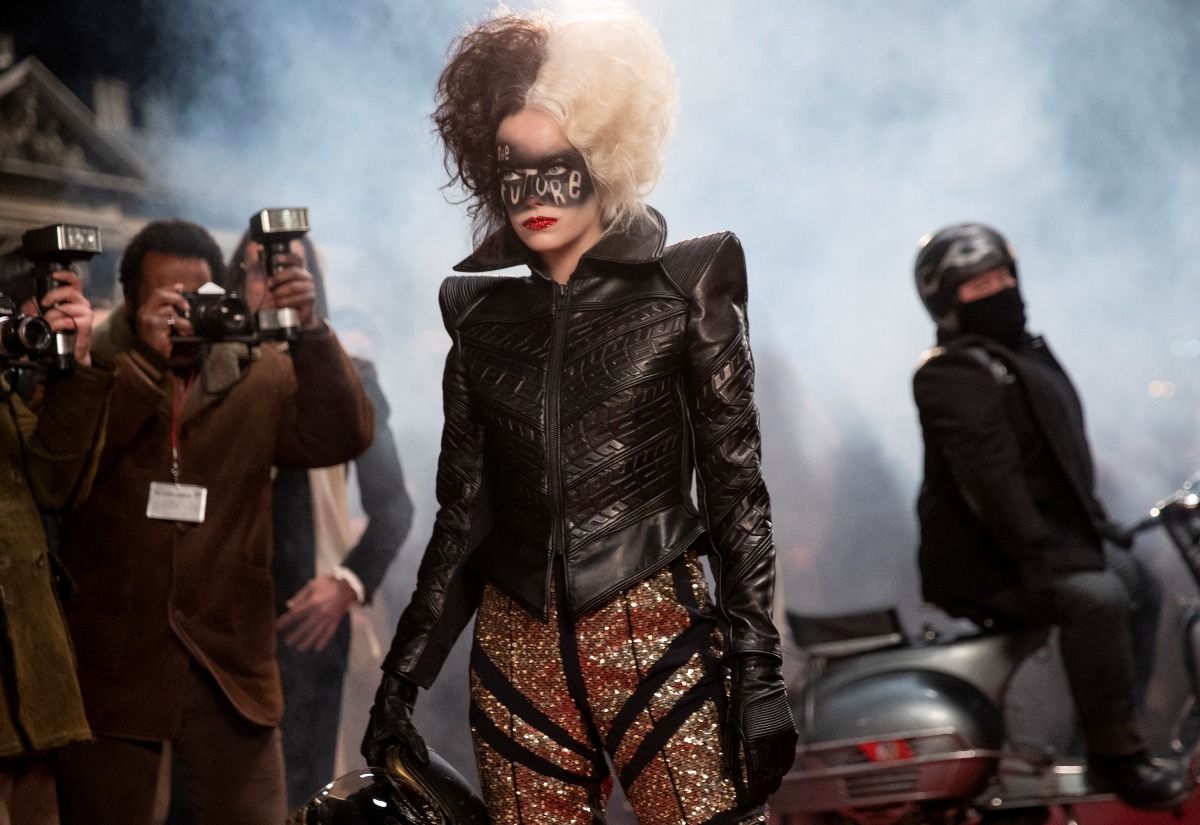It’s clear that fashion plays a very important role in the live-action origin story of legendary villain Cruella de Vil, and two-time Academy Award winning costume designer Jenny Beavan (Mad Max: Fury Road, A Room with a View) certainly had her work cut out for her. Set in 1970s London amidst the punk rock revolution, Cruella follows a clever and creative young grifter named Estella (Emma Stone) is determined to make a name for herself with her clothing designs. As her flair for the dramatic and penchant for mischief catches the eye of fashion icon Baroness von Hellman (Emma Thompson), it sets Estella on a path that will lead her to become the wicked Cruella.
During a virtual conference to discuss the extensive work she did for the film, Beavan talked about what inspired and influenced the looks for Cruella, how they approached the costume fittings, creating both individual wardrobe pieces along with fashion lines, whether it’s more fun to design for bad girls, and the challenges on a project like this.
Question: You’re no stranger to intricate costume work, but what inspired the looks for Cruella?
JENNY BEAVAN: Obviously, it was a massive undertaking because it is about fashion and it is about clothes. It’s quite a dense script, and you see a complete arc of her journey from being a young kid who’s rebellious and enjoys clothes to a fully-fledged, very individual type of fashion designer. We were in the ‘70s, and I was around in the ‘70s and remember it well. I didn’t have a lot of money then because I was still working in legitimate theater, but I certainly remember what people were wearing and the various influences that were around. When I started on it, I really looked at old magazines of the period. Vogue is very available online, so that was very useful for high fashion for the Baroness, to see what people were wearing. And for Cruella herself, Estella Cruella, there were a lot of wonderful Vivienne Westwood and Galliano type of looks. People were doing individual and interesting things, plus there was what I actually remembered of us all going to Portobello Vintage Market, buying bits and pieces, and putting them together. Military bits were very popular at the time, which you wore with jeans or a frilly skirt. It was about putting things together in an interesting way. We came out of the ‘50s, which were very straight-laced, to the ‘60s, which had an explosion of freedom, in every way, so the ‘70s were really an interesting period of making the freedom come into focus. That’s really where I looked for finding my way with her.
You created 47 looks for Emma Stone’s character. What was your process for figuring all of that out?
BEAVAN: I went to fit her in her home in Los Angeles. I took with me about ten suitcases of
pieces of clothing that were fun or might be right for something. It was a very random collection. It was more about just seeing how it worked. So, we arrived in the morning and we set up in the garage, and then we fitted her in her kitchen. Out of that first fitting came a huge number of the basis of the looks. We didn’t use many of the actual vintage pieces, but we used them as inspirations. That whole dress up day was one of the most rewarding bit of work. That’s when you really find out what will and won’t work, and you get input. Craig [Gillespie] came over and we all had a very jolly lunch. Emma’s lovely. Set costumer, Laura [Wolford], was there. We had a really, really great session. Out of all that, was the red dress. We bought a very cheap red dress in a shop in Beverly Hills to see what worked, but it was a really great color and she looked marvelous in it. At one point, I thought almost, “This could almost work, she looks so good.” But in the script and in the story, that dress has been created out of one of the Baroness’ dresses that she has seen a vintage store in Portobello, so it had to have credibility. The color was chosen because it’s a black and white ball, so it has to be the most standout color you can get, which for me was always going to be red and seems a very suitable Cruella color. The dress, itself, was a deconstruction of the Baroness’ dress. Over the bust, you can see the line that is taken from the Baroness’ original design, and then we cut it into strips and the amazing maker, Ian Wallace, actually put it together. The idea was that there was enough fabric in this dress, because it also had a massive stole that went with it, that you could just about believe that she made it from this original work that she found.
The Baroness is at the height of ‘70s fashion. What inspired the 33 looks that you created for the Baroness?
BEAVAN: I absolutely looked at the really high fashion of the period, particularly in Vogue.
I looked at Dior. I looked at Balenciaga. I looked at everybody. Emma Thompson has a stunningly good figure and loves wearing clothes like this. She really enjoys it, which also brings something to the whole costume. Some people just stand in it, but she embodies it. So, what I did was I went and bought fabric, really anything that felt it could be right. It needed to be fairly sculptured. It was all fabric with a good stiffness and body to it. And then, we draped it. We would drape on the stand and find the looks, and then decide what we could use for each scene. At one point, she needs to almost undress, or you see her getting into things, so we started to find where we could use things. We were making up great looks to then go shopping with it.
In addition to designing so many individual looks, you also had to create two fashion lines. What was that like?
BEAVAN: There’s the Baroness’ 18th century ball, which actually takes place in the ‘60s, not the ‘70s. That’s at the very beginning of Cruella’s journey, as a young girl, and where she starts her progression. The costumes that were made for that particular fashion show have a slightly Mary Antoinette influence. The guests are also in 18th century style clothing, but with ‘60s jewelry, hair and makeup because people don’t normally do full 18th century.
How do the actors inspire you, when it comes to designing their wardrobe?
BEAVAN: I know Emma Thompson really well. I know how she works and I know her body. This was so specifically designed, it wasn’t so much of a collaboration other than that, when we got the clothes to her and she really loved them, she actually enjoyed the whole process of having something brand new, for every fitting. It wasn’t quite like some films I do, which are totally collaborative with the actors. This was very much dictated by the script. The whole look of it was so important that I couldn’t really do some of my normal collaboration. It didn’t matter because we all got on well and they seemed to really enjoy what they were wearing. Emma Stone, I had never met before, but she’s another wonderful human being. She seems to embody and own the clothes when you put them on her, so that was great. In her first fitting, when we were going from the 20-year-old Estella into the very last looks, that was exciting because we were trying them on with her and she was totally collaborating and making it work, which was great.
Did you think about the performance, when you were creating this looks, as far as the type of entrances that Cruella would make in some of them?
BEAVAN: It had to be in complete contrast to the Baroness’ show. It’s a very straightforward typically good Baroness design that gets totally destroyed by the moths, so it’s the antithesis of that. That’s probably where the punk element came in the most. It had a real mixture of influences, with the ‘70s, military and fantastical, but also using old pieces in an ethical, re-purposed and recycled way. I thought was part of her ethos, too.
Is it more fun to design for bad girls?
BEAVAN: To be honest, it was enormous fun. I won’t say it was easy. We had a ridiculously short prep time. I did have a complete moment of terror and panic about whether I could ever do it, but remembered the wise words of a colleague who said to do it in bite-sized chunks rather than trying to do all at once, which is always good for anybody to know. The whole story is so rich and you’re given such an opportunity. You’ve got a punky girl. You’ve got all of her development. You’ve got her photo bomb opportunities. And then, you’ve got her developing into a much more stylish designer. Plus, you’ve got the Baroness. Once you’ve got the hang of how to do it, you could probably go on and do another 20 looks with the right fabrics. They’re just such fun. You throw it at the stand, drape it around, and hurl it here and then. It was enormous fun, I have to say.
This movie is centered in the ‘70s, but did you take any inspiration from the previous movies, either the live-action or the animated 101 Dalmations?
JENNY: Not really. It’s an origin movie, and those two are where our film ends up, years after. Those are set in the ‘90s and we’re in the ‘70s. So, no, other than the fact that the Cruella character does seem to be defined by black and white and there’s a bit of red that comes in, and the Dalmatians are an important part of it. I did look at Jasper and Horace, particularly in the animation, and felt that there was something lovely about the way they were drawn and their colors, so I slightly brought that into Joel Fry and Paul Walter Hauser’s costumes. They were probably the most influenced, in any way, by the animation. Otherwise, I just wanted to make sure that you could believe that, eventually, she could become Glenn Close, but that was about as far as my influence went.
Which one of all the looks was the most difficult to create?
BEAVAN: They all have challenges. I had an extremely brilliant team of makers. I had five cutters, all with different skills. I was blessed with a team of brilliant people. I’m sure they all cursed me, from time to time, with what I was asking them for, but it was so big, everybody put their ideas in and I would moderate what we did and didn’t do. There was a huge amount of input from the makers. People were having fun, as well as producing some extraordinary work. Everybody piled in on everything, in the end, particularly the fashion shows. It took a village.
How long did you actually work on this film?
BEAVAN: We originally only had 10 weeks prep. We gained an extra six weeks because Emma Stone had a minor shoulder injury that needed a lot of rest and recuperation, which saved our lives. We blessed her, on a daily basis. So, we got actually 16 weeks prep. And then, you’re also working through the filming schedule You have to keep working at it. I think we did a 14-week shoot. So, it was 16 weeks of prep and 14 weeks of the shoot, from start to finish.
Was Cruella the biggest challenge in your career, so far?
BEAVAN: I don’t think it was my biggest challenge. I would say Mad Max was because that was so out of my comfort zone. It also opened up a whole new career for me. Having done a huge amount of lovely period dramas, particularly English, the Victorian Age and Regency, I think people were slightly surprised that I could tackle the post-apocalyptic world. That was brilliant, but that was probably the biggest challenge because it couldn’t have been more out of my comfort zone. This was more in my comfort zone because I remember the ‘70s and the story is very clear. There are a lot of things to hang onto with Cruella. Our problem was time. I had an amazing crew and an amazing team, and somehow we did it, so bless them.
If you had to define the wardrobe of Cruella with a single theme, what would it be?
BEAVAN: I have absolutely no idea. I looked at the Met Gala for the big photo bomb dresses, particularly the one with the red petals on it. I don’t think you could define it with one word or one thing, really.
Cruella is in theaters and available to stream with Disney+ Premier Access on May 28th.




